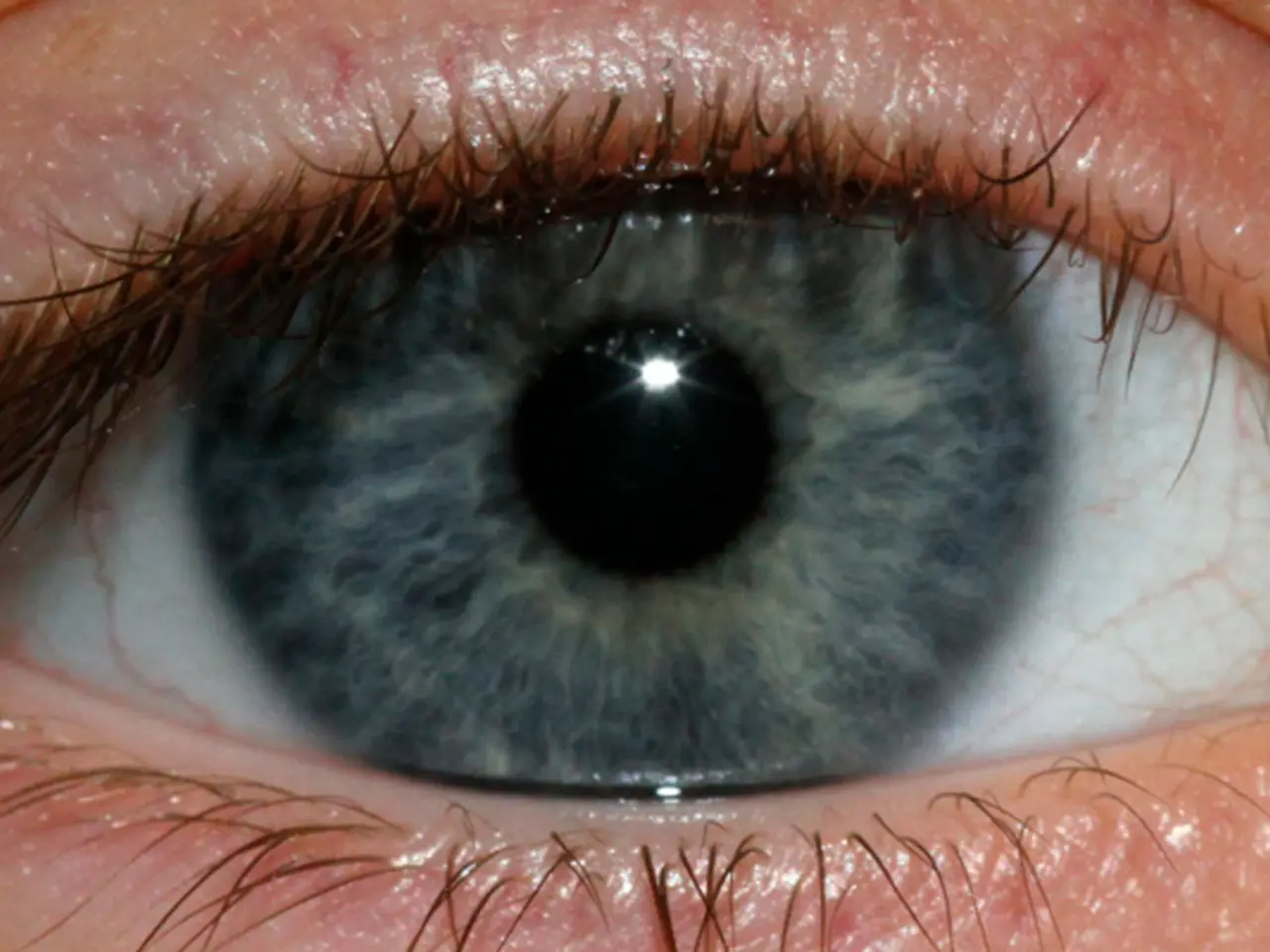Iris, the tinted component of an eye, is what we are referring to here.
In the fascinating world of the human eye, one key component that stands out is the iris – a thin, round, highly pigmented circular membrane located between the cornea and the lens. This vibrant structure plays a crucial role in controlling the diameter of the pupil in response to the intensity of light entering the eye.
Heterochromia, the presence of different eye colors in a person, is a fascinating phenomenon that can occur at birth or later in life. However, changes in eye color may also be indicative of underlying conditions.
One such condition is Fuchs Heterochromic Iridocyclitis (FHI), a rare inflammatory condition affecting the iris. It causes loss of iris pigmentation and changes in eye color, potentially leading to cataracts and glaucoma if left untreated. Symptoms may be subtle initially but can progress to blurred vision and increased eye pressure [1].
Another common iris-related condition is Acute Anterior Uveitis, or iritis, which is inflammation of the anterior uvea including the iris. Symptoms include deep eye pain, redness, sensitivity to light (photophobia), watery eye without discharge, blurred vision, and constricted pupil with less distinct iris markings. It can occur acutely with sudden onset or chronically and often is associated with systemic autoimmune diseases [3][4].
Other iris-related conditions include Lisch nodules, small brown spots on the iris usually linked with neurofibromatosis, a genetic disorder affecting nerve tissue growth. These do not typically cause symptoms but are a diagnostic sign [1]. Horner’s syndrome, caused by nerve damage affecting the sympathetic nervous system, results in changes in pupil size and iris depigmentation, which may alter eye color appearance [1].
Scleritis, inflammation of the sclera causing deep eye pain, and thyroid eye disease, which affects muscles and tissues around the eye causing bulging and dryness, are other autoimmune and inflammatory eye conditions affecting the iris or surrounding structures [2].
Medication-induced changes are also noted, for example, glaucoma drugs like prostaglandin analogs can cause permanent darkening of iris color [1].
In children with Waardenburg syndrome, a rare, inherited genetic condition that causes hearing loss and changes in the pigmentation of the hair, eyes, and skin, the goal is to improve hearing difficulties to promote mental development. Individuals with Waardenburg syndrome need sun protection since they are susceptible to sun damage [5]. Genetic counseling is critical for individuals with Waardenburg syndrome since the condition tends to run in families [6].
Symptoms that should prompt a person to seek medical attention include eye pain, headaches with blurred vision, tearing, trauma or injury to the eye, red-eye in the absence of trauma, light sensitivity, photophobia, vision loss [7]. Early diagnosis and prompt treatment may prevent severe complications such as total vision loss.
In conclusion, understanding common iris conditions is essential for maintaining eye health. These conditions involve inflammatory diseases, genetic markers, neurological syndromes, and drug-induced pigmentation changes. Symptoms range from color changes and spotting to eye pain, redness, light sensitivity, and vision changes. Early detection and treatment are essential to prevent complications such as vision loss or glaucoma.
References: [1] American Academy of Ophthalmology. (n.d.). Fuchs Heterochromic Iridocyclitis. Retrieved from https://www.aao.org/eye-health/diseases/fuchs-heterochromic-iridocyclitis-fhi-list [2] American Academy of Ophthalmology. (n.d.). Scleritis. Retrieved from https://www.aao.org/eye-health/diseases/scleritis-list [3] American Academy of Ophthalmology. (n.d.). Acute Anterior Uveitis. Retrieved from https://www.aao.org/eye-health/diseases/acute-anterior-uveitis-list [4] National Eye Institute. (n.d.). Uveitis. Retrieved from https://www.nei.nih.gov/learn-about-eye-health/eye-conditions-and-diseases/uveitis [5] American Academy of Ophthalmology. (n.d.). Waardenburg Syndrome. Retrieved from https://www.aao.org/eye-health/diseases/waardenburg-syndrome-list [6] Genetic and Rare Diseases Information Center. (n.d.). Waardenburg Syndrome. Retrieved from https://rarediseases.info.nih.gov/diseases/10391/waardenburg-syndrome [7] American Academy of Ophthalmology. (n.d.). Eye Emergencies. Retrieved from https://www.aao.org/eye-health/treatment/eye-emergencies
- Understanding various medical conditions, such as Fuchs Heterochromic Iridocyclitis, Acute Anterior Uveitis, and Waardenburg syndrome, is crucial for maintaining eye health.
- Cataracts and glaucoma may result from the rare inflammatory condition Fuchs Heterochromic Iridocyclitis if left untreated.
- Genetic counseling is essential for individuals with Waardenburg syndrome to manage their condition and prevent potential complications.
- Symptoms like eye pain, headaches with blurred vision, red-eye, light sensitivity, photophobia, and vision loss should prompt individuals to seek medical attention.




